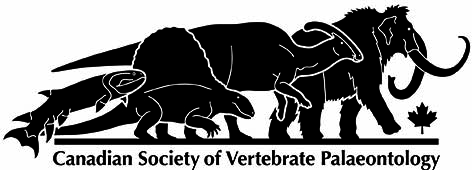Positional Variation in Pedal Ungulas of North American Ornithomimids (Dinosauria, Theropoda): A Response to Brownstein (2017)
DOI:
https://doi.org/10.18435/vamp29283Abstract
Positional variation is documented in ornithomimid pedal unguals from the Dinosaur Park and Horseshoe Canyon Formations of Alberta, Canada, and characters for identifying the position of isolated ornithomimid pedal unguals are discussed. Ungual morphology has been used recently to argue for the coexistence of two distinct ornithomimosaurs, a basal taxon and distinctly more derived taxon, in the Early Cretaceous Arundel Clay of Maryland, USA. However, these conclusions are based on misconceptions of the morphology and positional variability of ornithomimosaur unguals. Some characters previously cited as diagnostic of ornithomimosaur unguals are not actually observed in this clade, or are more homoplastically distributed among theropods. Other characters proposed to distinguish between the two pedal ungual morphs in the Arundel Clay material are shown in the Albertan ornithomimid material to consistently distinguish the different ungual positions within the pes of one individual. Claims of multiple distinct ornithomimosaur taxa in the Arundel Clay are premature, as the two pedal ungual morphotypes more likely represent positional variation in a single taxon.Downloads
References
Apesteguía, S., Smith, N. D., Juárez Valieri, R., and Makovicky, P. J. 2016. An unusual new theropod with a didactyl manus from the Upper Cretaceous of Patagonia, Argentina. PLoS One 11: e0157793, 1–41.
Barsbold, R., and Osmólska, H. 1990. Ornithomimosauria. In The Dinosauria. Edited by D. B. Weishampel, P. Dodson, and H. Osmólska. University of California Press, Berkeley, California. pp. 225–244.
Brownstein, C. D. 2017. Description of Arundel Clay ornithomimosaur material and a reinterpretation of Nedcolbertia justinhofmanni as an “Ostrich Dinosaur”: biogeographic implications. PeerJ 5:e3110, 1–20.
Buffetaut, E., Suteethorn, V., and Tong, H. 2009. An early ‘ostrich dinosaur’ (Theropoda: Ornithomimosauria) from the Early Cretaceous Sao Khua Formation of NE Thailand. The Geological Society, London, Special Publications 315:229–243.
Choiniere, J. N., Forster, C. A., and de Klerk, W. J. 2012. New information on Nqwebasaurus thwazi, a coelurosaurian theropod from the Early Cretaceous Kirkwood Formation in South Africa. Journal of African Earth Sciences 71–72:1–17.
Cullen, T. M., Ryan, M. J., Schröder-Adams, C., Currie, P. J., and Kobayashi, Y. 2013. An ornithomimid (Dinosauria) bonebed from the Late Cretaceous of Alberta, with implications for the behavior, classification, and stratigraphy of North American ornithomimids. PLoS One, 8:e58853, 1–9.
Gilmore, C. W. 1920. Osteology of the carnivorous Dinosauria in the United States National Museum, with special reference to the genera Antrodemus (Allosaurus) and Ceratosaurus. United States National Museum Bulletin 110:1–154.
Ibrahim, N., Sereno, P. C., Dal Sasso, C., Maganuco, S., Fabbri, M., Martill, D. M., Zouhri, S., Myhrvold, N., and Iurino, D. A. 2014. Semiaquatic adaptations in a giant predatory dinosaur. Science 345:1613–1616.
Ji, Q., Norell, M. A., Makovicky, P. J., Gao, K.-Q., Ji, S., and Yuan, C. An early ostrich dinosaur and implications for ornithomimosaur phylogeny. American Museum Novitates 3420:1–19.
Jin, L., Chen, J., and Godefroit, P. 2012. A new basal ornithomimosaur (Dinosauria: Theropoda) from the Early Cretaceous Yixian Formation, northeast China. In Bernissart Dinosaurs and Early Cretaceous Terrestrial Ecosystems. Edited by P. Godefroit. Indiana University Press, Bloomington, Indiana. pp. 466–487.
Kobayashi, Y. and Lü, J.-C. 2003. A new ornithomimid dinosaur with gregarious habits from the Late Cretaceous of China. Acta Palaeontologica Polonica 48:235–259.
Lambe, L. M. 1902. New genera and species from the Belly River Series (mid−Cretaceous). Geological Survey of Canada, Contributions to Canadian Paleontology 3:25–81.
Longrich, N. R. 2008. A new, large ornithomimid from the Cretaceous Dinosaur Park Formation of Alberta, Canada: implications for the study of dissociated dinosaur remains. Palaeontology 51:983–997.
Makovicky, P. J., Kobayashi, Y., and Currie, P. J. 2004. Ornithomimosauria. In The Dinosauria, Second Edition. Edited by D. B. Weishampel, P. Dodson, and H. Osmólska. University of California Press, Berkeley, California. pp. 137–150.
Makovicky, P. J., Li, D., Gao, K.-Q., Lewin, M., Erickson, G. M., and Norell, M. A. 2009. A giant ornithomimosaur from the Early Cretaceous of China. Proceedings of the Royal Society B 277:191–198.
McFeeters, B., Ryan, M. J., Schröder-Adams, C., and Cullen, T. M. 2016. A new ornithomimid theropod from the Dinosaur Park Formation of Alberta, Canada. Journal of Vertebrate Paleontology 36:e1221415, 1–20.
Novas, F. E., Dalla Vecchia, F., and Pais, D. F. 2005. Theropod pedal unguals from the Late Cretaceous (Cenomanian) of Morocco, Africa. Revista del Museo Argentino de Ciencias Naturales, Nueva Serie 7:167–175.
Osmólska, H., Roniewicz, E., and Barsbold, R. 1972. A new dinosaur, Gallimimus bullatus n. gen., n. sp. (Ornithomimidae) from the Upper Cretaceous of Mongolia. Palaeontologia Polonica 27:103–143.
Schwimmer, D. R., Sanders, A. E., Erickson, B. R., and Weems, R. E. 2015. A Late Cretaceous dinosaur and reptile assemblage from South Carolina, USA. Transactions of the American Philosophical Society 105 (2):1–157.
Serrano-Brañas, C. I., Torres-Rodríguez, E., Reyes-Luna, P. C., González-Ramírez, I., and González-León, C. 2016. A new ornithomimid dinosaur from the Upper Cretaceous Packard Shale formation (Cabullona Group) Sonora, México. Cretaceous Research 58:49–62.
Sternberg, C. M. 1933. A new Ornithomimus with complete abdominal cuirass. Canadian Field-Naturalist 47:79–83.
Downloads
Published
How to Cite
Issue
Section
License
Copyright (c) 2018 Bradley McFeeters, Michael J. Ryan, Thomas M. Cullen

This work is licensed under a Creative Commons Attribution 4.0 International License.
Submission of an article to Vertebrate Anatomy Morphology Palaeontology will be taken to mean that the article is an original work and not previously published or under consideration for publication elsewhere.
If the article is accepted for publication, it will be published on-line under Creative Commons Attribution 4.0 International (CC By 4.0) meaning:
Attribution — You must give appropriate credit, provide a link to the license, and indicate if changes were made. You may do so in any reasonable manner, but not in any way that suggests the licensor endorses you or your use.
No additional restrictions — You may not apply legal terms or technological measures that legally restrict others from doing anything the license permits.






